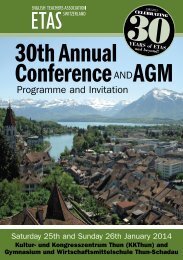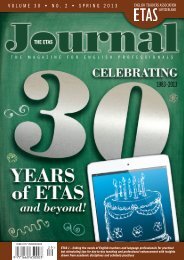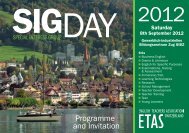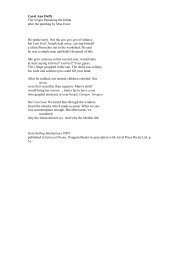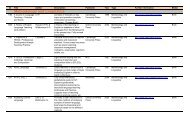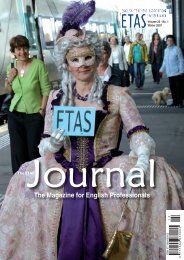Teaching English to Young Learners - English Teachers Association ...
Teaching English to Young Learners - English Teachers Association ...
Teaching English to Young Learners - English Teachers Association ...
Create successful ePaper yourself
Turn your PDF publications into a flip-book with our unique Google optimized e-Paper software.
EDITOR’S NOTES<br />
“To educate as the practice of freedom is a way of teaching that anyone can learn.<br />
That learning process comes easiest <strong>to</strong> those of us who teach who also believe that there<br />
is an aspect of our vocation that is sacred; who believe that our work is not merely <strong>to</strong> share<br />
information but <strong>to</strong> share in the intellectual and spiritual growth of our students. To teach in a<br />
manner that respects and cares for the souls of our students is essential if we are <strong>to</strong><br />
provide the necessary conditions where learning can most deeply and intimately begin.”<br />
bell hooks, <strong>Teaching</strong> <strong>to</strong> transgress: education as the practice of freedom (1994, p. 13)<br />
In this issue. I have a few sources of<br />
exhilaration in this issue. First, it tells me<br />
that our ETAS community is alive and vital.<br />
Second, this issue is bigger because our<br />
Call for Articles is reaching our prospective<br />
readers and inspiring them <strong>to</strong> respond<br />
enthusiastically. And third, this issue<br />
contains new sections that I hope will<br />
continue <strong>to</strong> grow and attract contribu<strong>to</strong>rs.<br />
The result is this impressive collection of<br />
writings that range from studies with<br />
sound theoretical frameworks <strong>to</strong> articles<br />
with clear pedagogical implications and/or<br />
applications in the areas of new materials<br />
or materials preparation, innovative<br />
classroom practices, needs assessment,<br />
curriculum design and development,<br />
IT application in learning/teaching<br />
strategies, second language writing and<br />
reading, cultural dimensions of language<br />
teaching and learning, and the impact of<br />
language and educational policies on<br />
classroom practice.<br />
Yet, in the beginning we were not working<br />
<strong>to</strong>ward any overriding theme. However, as<br />
the issue grew, it became clear that the<br />
pieces do speak <strong>to</strong> one another and the<br />
underlying themes and overt connections<br />
suggest themselves in a serendipi<strong>to</strong>us way.<br />
I have spoken about this notion of dialog<br />
in my previous writings and this issue<br />
reaffirms my belief in ETAS J as a splendid<br />
forum on which the various views on<br />
<strong>English</strong> language teaching are reflecting and<br />
responding <strong>to</strong> one another. It is inevitable,<br />
of course, because ETAS J’s mission is <strong>to</strong><br />
illuminate and perpetuate this dialog<br />
between and among ELT professionals.<br />
Our aim is <strong>to</strong> continue <strong>to</strong> offer our<br />
colleagues in the ELT profession not only<br />
good things <strong>to</strong> read, but also an enhanced<br />
sense of community, a chance <strong>to</strong> come<br />
out in<strong>to</strong> the open, and compare notes.<br />
Providing both the inspiration and the<br />
philosophical underpinnings for this issue<br />
are excerpts from three of my favourite<br />
writers: bell hooks, e. e. cummings, and<br />
Toni Morrison. Despite the diversity of their<br />
themes and the variety of genres in which<br />
they thrive, these three writers share a<br />
passionate commitment <strong>to</strong> a humanist<br />
educational philosophy which favors the<br />
“I would rather learn from one bird how <strong>to</strong> sing than <strong>to</strong> teach<br />
10,000 stars how not <strong>to</strong> dance.”<br />
e. e. cummings<br />
“We die. That may be the meaning of life. But we do language.<br />
That may be the measure of our lives.”<br />
Toni Morrison<br />
notion that learning is about making better<br />
people and not merely about altering<br />
behaviors. “My hope emerges from those<br />
places of struggle where I witness individuals<br />
positively transforming their lives and the<br />
world around them. Educating is always a<br />
vocation rooted in hopefulness. As teachers<br />
we believe that learning is possible, that<br />
nothing can keep an open mind from<br />
seeking after knowledge and finding a way<br />
<strong>to</strong> know.” Thus opens bell hook’s wonderful<br />
work, <strong>Teaching</strong> community: a pedagogy of<br />
hope (2003), in which she deepens her<br />
exploration of the meaning of engaged<br />
pedagogy she earlier developed in <strong>Teaching</strong><br />
<strong>to</strong> transgress: education as the practice of<br />
freedom (1994), in particular the process<br />
of building community in the classroom.<br />
For bell hooks, engaged pedagogy is<br />
about liberation and a specific mode of<br />
thinking about learning: education is not<br />
merely about enabling students <strong>to</strong>wards<br />
self-actualization; teaching itself should<br />
empower teachers and move them further<br />
in that direction. hooks’s notion of<br />
“education as the practice of freedom” calls<br />
for educa<strong>to</strong>rs <strong>to</strong> go beyond the ‘teacherly’<br />
selves that they bring in<strong>to</strong> the classroom<br />
and <strong>to</strong> show their whole selves. In other<br />
words, we as teachers must bring <strong>to</strong> it all<br />
of ourselves, our own lives a reflection of<br />
the kind of education that is not merely<br />
about knowing facts and understanding<br />
concepts but also about learning how <strong>to</strong> live<br />
life, and live it <strong>to</strong> the fullest. When students<br />
experience liberation through learning, only<br />
then will engagement become something<br />
more than “real learning”. “The academy<br />
is not paradise,” says hooks, “but learning<br />
is a place where paradise can be created.<br />
The classroom, with all its limitations,<br />
remains a location of possibility. In the<br />
field of possibility we have the opportunity<br />
<strong>to</strong> labor for freedom, <strong>to</strong> demand of ourselves<br />
[...] an openness of mind and heart that<br />
allows us <strong>to</strong> face reality even as we<br />
collectively imagine ways <strong>to</strong> move beyond<br />
boundaries, <strong>to</strong> transgress. This is education<br />
as the practice of freedom” (1994, p. 207).<br />
hooks’s ideas find resonances in the<br />
collection of articles included in the Special<br />
Supplement on <strong>Teaching</strong> <strong>English</strong> <strong>to</strong> <strong>Young</strong><br />
<strong>Learners</strong>. In spite of the variety of their<br />
subjects and approaches, the authors<br />
espouse the central beliefs that (a) every<br />
child can learn in the right circumstances<br />
and that we, as educa<strong>to</strong>rs, need <strong>to</strong> adapt<br />
<strong>to</strong> meet the needs of our children, and (b)<br />
that learning must be engaging, social, and<br />
centered on the needs and strengths of the<br />
pupils. And all of them agree that when<br />
teachers align their beliefs with their<br />
practice, students succeed.<br />
Acknowledgments. This issue once again<br />
demonstrates that collaboration is the stuff<br />
of growth. No journal can function without<br />
the input from authors, production staff,<br />
and Edi<strong>to</strong>rial Board members. Therefore, I<br />
wish <strong>to</strong> express my appreciation and thanks<br />
<strong>to</strong> all contribu<strong>to</strong>rs <strong>to</strong> this edition for their<br />
dedication, patience, and tremendous help<br />
in preparing this issue. Ruth Benvegnen<br />
and Joy Cosslett deserve special mention<br />
for their wonderful efforts in putting <strong>to</strong>gether<br />
the Special Supplement on <strong>Teaching</strong><br />
<strong>English</strong> <strong>to</strong> <strong>Young</strong> <strong>Learners</strong>. And they are<br />
every edi<strong>to</strong>r’s dream collabora<strong>to</strong>rs – for<br />
completing this project remarkably long<br />
before the deadline, they have given a new<br />
meaning <strong>to</strong> punctuality.<br />
Readers will notice some changes in the<br />
format and content of this volume and I<br />
have Julie Mangold, JoAnn Salvisberg, Illya<br />
Arnet-Clark, and Dorothy Sommer <strong>to</strong> thank<br />
for paving the way for the rest of our<br />
members <strong>to</strong> take a more active part in<br />
our publication. Their contributions have<br />
given life <strong>to</strong> my dreams <strong>to</strong> introduce<br />
specific sections, beginning with this issue.<br />
For being generous with their time and<br />
expertise, Illya and Dorothy have my<br />
gratitude. Though among the busiest, they<br />
are also the most committed, and they<br />
did not let me down when I requested<br />
their participation in this issue at very<br />
short notice.<br />
A number of friends and colleagues, many<br />
of them I have yet <strong>to</strong> meet in person,<br />
have sent email or text messages of<br />
congratulations and encouragement for<br />
our work on ETAS J. These heartwarming<br />
messages accompanied the completion<br />
of this issue, providing the much-needed<br />
ETAS Journal 28/3 Summer 2011 5



